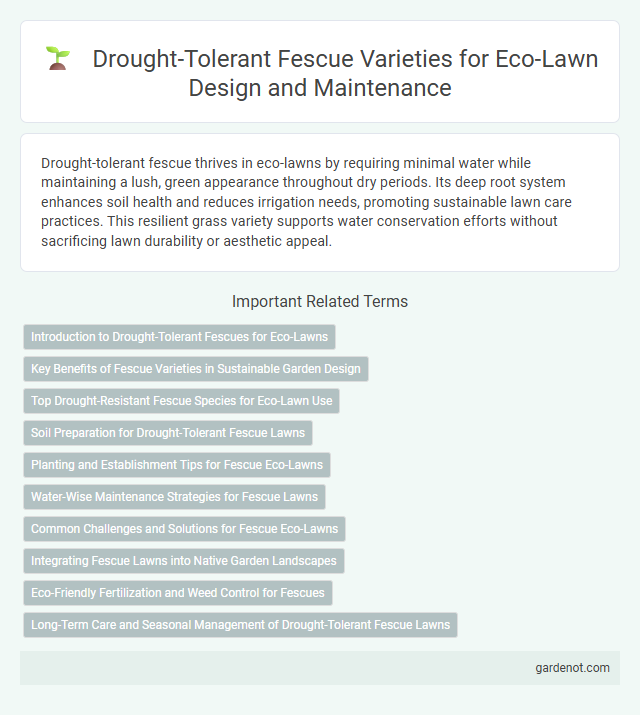Drought-tolerant fescue thrives in eco-lawns by requiring minimal water while maintaining a lush, green appearance throughout dry periods. Its deep root system enhances soil health and reduces irrigation needs, promoting sustainable lawn care practices. This resilient grass variety supports water conservation efforts without sacrificing lawn durability or aesthetic appeal.
Introduction to Drought-Tolerant Fescues for Eco-Lawns
Drought-tolerant fescue grasses, particularly fine fescue varieties such as hard fescue, chewings fescue, and sheep fescue, are ideal for eco-lawns due to their exceptional ability to withstand extended dry periods with minimal water. These grasses feature deep root systems and a slow growth rate, reducing maintenance needs and conserving water resources. Incorporating drought-tolerant fescues in eco-lawn seed mixes promotes sustainable landscaping by enhancing soil health and supporting biodiversity.
Key Benefits of Fescue Varieties in Sustainable Garden Design
Drought-tolerant fescue varieties significantly reduce water consumption due to their deep root systems and efficient water use, making them ideal for sustainable garden design. These grasses maintain a lush, green appearance even under extended dry conditions, minimizing the need for supplemental irrigation. Their low maintenance requirements and resilience to heat stress contribute to eco-friendly landscapes by conserving resources and reducing environmental impact.
Top Drought-Resistant Fescue Species for Eco-Lawn Use
Top drought-resistant fescue species for eco-lawn use include Tall Fescue (Festuca arundinacea), Hard Fescue (Festuca trachyphylla), and Sheep Fescue (Festuca ovina), prized for their deep root systems and low water requirements. Tall Fescue stands out with exceptional heat and drought tolerance, making it ideal for sustainable lawns in arid regions. Hard and Sheep Fescue varieties excel in poor soil conditions while maintaining green coverage during dry spells, supporting eco-friendly landscaping goals.
Soil Preparation for Drought-Tolerant Fescue Lawns
Effective soil preparation for drought-tolerant fescue lawns involves deep aeration to enhance oxygen flow and promote root growth in compacted soils. Incorporating organic matter like compost improves soil structure and moisture retention critical for drought resilience. Testing soil pH and amending it to 6.0-7.0 ensures optimal nutrient availability for fescue grass establishment and long-term health.
Planting and Establishment Tips for Fescue Eco-Lawns
Drought-tolerant fescue varieties, such as tall fescue and hard fescue, thrive in eco-lawn settings due to their deep root systems and low water requirements. For optimal planting, sow fescue seeds in early spring or fall, ensuring well-prepared soil with good drainage and moderate fertility to enhance seed germination and establishment. Consistent, light watering during the initial weeks encourages strong root development, while reducing irrigation gradually helps the lawn adapt to drought conditions sustainably.
Water-Wise Maintenance Strategies for Fescue Lawns
Drought-tolerant fescue varieties, such as tall fescue and hard fescue, thrive under water-wise lawn care by requiring significantly less irrigation compared to traditional turfgrasses. Implementing deep, infrequent watering techniques promotes deep root growth, enhancing drought resistance and reducing water consumption. Mowing fescue lawns at a higher height helps retain soil moisture and improves overall lawn resilience during dry periods.
Common Challenges and Solutions for Fescue Eco-Lawns
Drought-tolerant fescue in eco-lawns often faces challenges such as soil compaction, uneven watering, and pest infestations, which can stress the grass and reduce its resilience. Solutions include aerating the soil to improve root growth, implementing drip irrigation systems to ensure consistent moisture, and using integrated pest management to control insects without harming the ecosystem. Proper mowing practices and soil amendments with organic matter also enhance drought tolerance and lawn health.
Integrating Fescue Lawns into Native Garden Landscapes
Drought-tolerant fescue grasses thrive in native garden landscapes by requiring minimal irrigation while maintaining lush, green coverage. Their deep root systems improve soil stability and support local biodiversity, making them an eco-friendly choice for sustainable lawn design. Integrating fescue lawns enhances water conservation efforts and complements native plantings with low-maintenance, resilient ground cover.
Eco-Friendly Fertilization and Weed Control for Fescues
Drought-tolerant fescue thrives with eco-friendly fertilization methods, utilizing organic compost and slow-release nitrogen to promote sustainable growth and minimize environmental impact. Integrating natural weed control techniques, such as manual removal and corn gluten meal applications, reduces reliance on synthetic herbicides, preserving soil health. These practices enhance resilience and maintain a vibrant, low-maintenance eco-lawn while supporting local biodiversity.
Long-Term Care and Seasonal Management of Drought-Tolerant Fescue Lawns
Drought-tolerant fescue lawns require minimal irrigation, making them ideal for arid regions and water-conscious landscapes. Seasonal management includes early fall overseeding and spring aeration to maintain turf density and root health. Long-term care focuses on balanced nitrogen fertilization and proper mowing height to sustain drought resistance and vibrant green color year-round.
Drought-tolerant fescue Infographic

 gardenot.com
gardenot.com